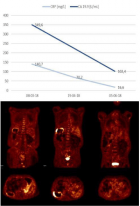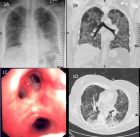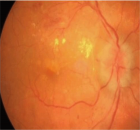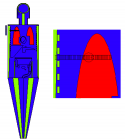Abstract
Case Report
Direct Carotid Puncture for Flow Diverter Stent Insertion
Bhogal P*, Phillips TJ and Makalanda HLD
Published: 30 June, 2017 | Volume 1 - Issue 1 | Pages: 024-028
Objective: To report our experience of direct carotid puncture and its use in the management of a large and rapidly expanding cavernous aneurysm.
Methods: A patient with a cavernous aneurysm that measured 25mm in maximum diameter underwent treatment with flow diversion. The initial treatment strategy was parent vessel occlusion however she failed the balloon occlusion test at 3 minutes. Due to extremely tortuous vessels stable access via a common femoral artery approach was impossible to achieve. We present our strategy, the post-operative management and long term results.
Results: Using a direct carotid puncture three telescoped Pipeline embolisation devices were successfully deployed across the neck of the cavernous aneurysm without complication. The puncture site formed a stable platelet plug after direct compression with an ultrasound probe for 90 minutes with no post-operative complications either intracranially or at the neck puncture site. At 2 year follow-up the aneurysm is completely excluded from the circulation.
Conclusion: Direct carotid puncture can be used as access for intracranial interventional procedures even if patients are on dual anti-platelet medication.
Read Full Article HTML DOI: 10.29328/journal.jnnd.1001004 Cite this Article Read Full Article PDF
Keywords:
Aneurysm; Flow diverter; Stent; Carotid puncture
References
- Aletich VA, Debrun GM, Misra M, Charbel F, Ausman JI. The remodeling technique of balloon-assisted Guglielmi detachable coil placement in wide-necked aneurysms: experience at the University of Illinois at Chicago. J Neurosurg. 2000; 93: 388-396. Ref.: https://goo.gl/PuAqdw
- Blanc R, Piotin M, Mounayer C, Spelle L, Moret J. Direct cervical arterial access for intracranial endovascular treatment. Neuroradiology. 2006; 48: 925-929. Ref.: https://goo.gl/9k8njH
- Nii K, Kazekawa K, Onizuka M, Aikawa H, Tsutsumi M, et al. Direct Carotid Puncture for the Endovascular Treatment of Anterior Circulation Aneurysms. Am J Neuroradiol. 2006; 27: 1502-1504. Ref.: https://goo.gl/VMDZWU
- Guimaraens L, Theron J, Casasco A, Cuellar H. Carotid artery stenting by direct percutaneous puncture. J Vasc Surg. 2011; 54: 249-251. Ref.: https://goo.gl/XjMbct
- Perez-Arjona EA, Delprosto Z, Fessler RD. Direct percutaneous carotid artery stenting with distal protection: technical case report. Neurol Res. 2004; 26: 338-341. Ref.: https://goo.gl/NVRMSu
- Dorfer C, Standhardt H, Gruber A, Ferraz-Leite H, Knosp E, et al. Direct percutaneous puncture approach versus surgical cutdown technique for intracranial neuroendovascular procedures: technical aspects. World Neurosurg. 2012; 77: 192-200. Ref.: https://goo.gl/Mti6ai
- Takata H, Iida T, Akai T, Kumano K, Iizuka H, et al. Coil embolization for intracranial aneurysm by direct puncture of the carotid artery in elderly patients. Interv Neuroradiol. 1998; 4: 75-76. Ref.: https://goo.gl/1PHA57
- Yuzawa I, Kurata A, Suzuki S, Ozawa H, Hagiwara H, et al. Efficacy of a direct puncture approach for anterior circulation aneurysms using a newly developed guiding catheter - especially for geriatric patients. Surg Neurol. 2007; 67: 30-34. Ref.: https://goo.gl/fdjuoy
- Blanc R, Mounayer C, Piotin M, Sadik JC, Spelle L, et al. Hemostatic closure device after carotid puncture for stent and coil placement in an intracranial aneurysm: technical note. AJNR Am J Neuroradiol. 2002; 23: 978-981. Ref.: https://goo.gl/cfgSq2
- Modi S, Gadvi R, Babu S. Initial experience with AngiosealTM: Safety and efficacy of the endovascular closure device. Indian J Radiol Imaging. 2013; 23: 134-138. Ref.: https://goo.gl/aaaMVv
- Corley JA, Kasliwal MK, Tan LA, Lopes DK. Delayed Vascular Claudication Following Diagnostic Cerebral Angiography: A Rare Complication of the AngioSeal Arteriotomy Closure Device. J Cerebrovasc Endovasc Neurosurg. 2014; 16: 275-280. Ref.: https://goo.gl/nN5b8v
- Lewis-Carey MB, Kee ST. Complications of arterial closure devices. Tech Vasc Interv Radiol. 2003; 6: 103-106. Ref.: https://goo.gl/QSyVa6
Figures:

Figure 1

Figure 2
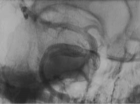
Figure 3
Similar Articles
-
Direct Carotid Puncture for Flow Diverter Stent InsertionBhogal P*,Phillips TJ, Makalanda HLD. Direct Carotid Puncture for Flow Diverter Stent Insertion. . 2017 doi: 10.29328/journal.jnnd.1001004; 1: 024-028
-
Endovascular management of tandem occlusions in stroke: Treatment strategies in a real-world scenarioJuan J Cirio*,Celina Ciardi,Matias Lopez,Esteban V Scrivano,Javier Lundquist,Ivan Lylyk,Nicolas Perez,Pedro Lylyk. Endovascular management of tandem occlusions in stroke: Treatment strategies in a real-world scenario. . 2021 doi: 10.29328/journal.jnnd.1001051; 5: 055-060
Recently Viewed
-
Sensitivity and Intertextile variance of amylase paper for saliva detectionAlexander Lotozynski*. Sensitivity and Intertextile variance of amylase paper for saliva detection. J Forensic Sci Res. 2020: doi: 10.29328/journal.jfsr.1001017; 4: 001-003
-
Extraction of DNA from face mask recovered from a kidnapping sceneBassey Nsor*,Inuwa HM. Extraction of DNA from face mask recovered from a kidnapping scene. J Forensic Sci Res. 2022: doi: 10.29328/journal.jfsr.1001029; 6: 001-005
-
The Ketogenic Diet: The Ke(y) - to Success? A Review of Weight Loss, Lipids, and Cardiovascular RiskAngela H Boal*, Christina Kanonidou. The Ketogenic Diet: The Ke(y) - to Success? A Review of Weight Loss, Lipids, and Cardiovascular Risk. J Cardiol Cardiovasc Med. 2024: doi: 10.29328/journal.jccm.1001178; 9: 052-057
-
Could apple cider vinegar be used for health improvement and weight loss?Alexander V Sirotkin*. Could apple cider vinegar be used for health improvement and weight loss?. New Insights Obes Gene Beyond. 2021: doi: 10.29328/journal.niogb.1001016; 5: 014-016
-
Maximizing the Potential of Ketogenic Dieting as a Potent, Safe, Easy-to-Apply and Cost-Effective Anti-Cancer TherapySimeon Ikechukwu Egba*,Daniel Chigbo. Maximizing the Potential of Ketogenic Dieting as a Potent, Safe, Easy-to-Apply and Cost-Effective Anti-Cancer Therapy. Arch Cancer Sci Ther. 2025: doi: 10.29328/journal.acst.1001047; 9: 001-005
Most Viewed
-
Evaluation of Biostimulants Based on Recovered Protein Hydrolysates from Animal By-products as Plant Growth EnhancersH Pérez-Aguilar*, M Lacruz-Asaro, F Arán-Ais. Evaluation of Biostimulants Based on Recovered Protein Hydrolysates from Animal By-products as Plant Growth Enhancers. J Plant Sci Phytopathol. 2023 doi: 10.29328/journal.jpsp.1001104; 7: 042-047
-
Sinonasal Myxoma Extending into the Orbit in a 4-Year Old: A Case PresentationJulian A Purrinos*, Ramzi Younis. Sinonasal Myxoma Extending into the Orbit in a 4-Year Old: A Case Presentation. Arch Case Rep. 2024 doi: 10.29328/journal.acr.1001099; 8: 075-077
-
Feasibility study of magnetic sensing for detecting single-neuron action potentialsDenis Tonini,Kai Wu,Renata Saha,Jian-Ping Wang*. Feasibility study of magnetic sensing for detecting single-neuron action potentials. Ann Biomed Sci Eng. 2022 doi: 10.29328/journal.abse.1001018; 6: 019-029
-
Pediatric Dysgerminoma: Unveiling a Rare Ovarian TumorFaten Limaiem*, Khalil Saffar, Ahmed Halouani. Pediatric Dysgerminoma: Unveiling a Rare Ovarian Tumor. Arch Case Rep. 2024 doi: 10.29328/journal.acr.1001087; 8: 010-013
-
Physical activity can change the physiological and psychological circumstances during COVID-19 pandemic: A narrative reviewKhashayar Maroufi*. Physical activity can change the physiological and psychological circumstances during COVID-19 pandemic: A narrative review. J Sports Med Ther. 2021 doi: 10.29328/journal.jsmt.1001051; 6: 001-007

HSPI: We're glad you're here. Please click "create a new Query" if you are a new visitor to our website and need further information from us.
If you are already a member of our network and need to keep track of any developments regarding a question you have already submitted, click "take me to my Query."







